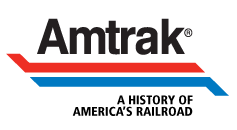Digging into the Archives: A look at the Auto Train
CommentsJune 20, 2012

Illustration from the 1984 Amtrak Annual Report shows
check-in at the Auto Train By mid-June, warm weather and the quiet of the school yard help turn our minds to thoughts of fun in the sun. Most people plan a summer vacation, whether it’s a week to the beach or a mountain hideaway, or perhaps just a few days off of work to rest and recharge. A long-popular destination for families has been central Florida, which offers access to Disney World and other theme parks, or the Gulf and Atlantic coast beaches for which the state is world-renowned.
For residents of the Northeast, one of the easiest ways to make that trip south is aboard the Auto Train, the only Amtrak service to simultaneously transport passengers and their motor vehicles, including cars, SUVs, trucks, motorcycles, small boats, and water-skis. Connecting the suburbs of Washington, D.C. and Orlando, this non-stop train allows passengers to skip nearly 900 miles of driving along the congested I-95 corridor.
While many people associate the Auto Train idea with Amtrak, it was actually initiated by a private company led by Eugene K. Garfield, who had once worked for the U.S. Department of Transportation (U.S.DOT). In the 1960s, U.S.DOT undertook a study to determine if an auto-ferry service could be as successful in America as it had been in Europe. The report was favorable, but federal officials believed that such an enterprise should be left to the private sector.
Garfield seized on the opportunity and in 1969 founded the Auto-Train Corporation. This was a period of great change in American passenger railroading. The next year, Congress enacted the Rail Passenger Service Act, which authorized the creation of Amtrak. It took some time for Garfield to raise money and arrange for trackage agreements, but on July 15, 1971—only six weeks after Amtrak had taken over most of the country’s remaining passenger train services—the company went public. Offering 700,000 shares at $10 each, seven million dollars was raised to purchase equipment for this new common carrier—the first established in more than 50 years. Auto-Train service began on December 6, 1971 with daily trips in both directions.
The Auto-Train proved quite popular, so much so that on May 24, 1974, weekend service between Louisville, Ky., and Sanford, Fla., was established. Unfortunately, two major derailments coupled with a lack of success on the Louisville–Sanford run marked the beginning of the end for the corporation. By 1981, the company ceased operations.
In 1983, Amtrak conducted a feasibility study to investigate a restoration of the Auto-Train. According to that year’s annual report, “Amtrak received over 400 requests for reservations on the train before a decision had even been made to begin the service.” In April, the Amtrak Board of Directors authorized planning for the new service, which began that October. A brochure printed for the inauguration of the revamped Auto Train (Amtrak eliminated the hyphen in the name) touted the passenger’s ability to “socialize in the lounge. Enjoy entertainment like a feature movie. Or quietly relax in our Dome Car…”
Feedback was very positive: an Amtrak customer survey indicated that “96 percent of passengers…rated Amtrak Auto Train ‘excellent’ for the courtesy of our people, the cleanliness of our equipment and the quality of the meals. Ridership was strong—55,000 in its first year.” Daily service was instituted in 1984 to meet growing demand.
The process of loading the cars and making up the train hasn’t changed much over the decades. Once at the station, passengers drive through a vehicle gate, receive a claim-check number which is also affixed to their vehicles, and then proceed to the loading area. Informational brochures given to passengers have a special section inside the cover with space to write down one’s car loading number and seat number. Travelers continue on foot into the station with their overnight luggage while the vehicles are video-documented and driven into the bi-level auto-rack rail cars, which are split up onto several parallel tracks. After loading, the rail cars and the passenger cars are made up into a single train—measuring approximately ¾ of a mile long—considered the longest passenger train in the world.
Auto Train carried nearly 260,000 passengers in 2011 and removed more than 126,000 vehicles from major highways. In late 2010, a new $10.5 million station opened in Sanford to replace one that had been damaged during the 2004 hurricane season.




